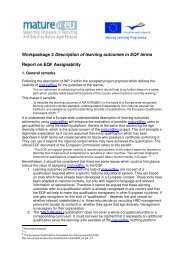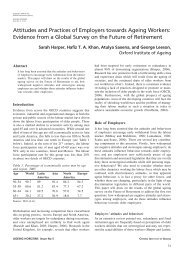Age profiling - Mature @ EU
Age profiling - Mature @ EU
Age profiling - Mature @ EU
- No tags were found...
Create successful ePaper yourself
Turn your PDF publications into a flip-book with our unique Google optimized e-Paper software.
<strong>Age</strong> <strong>profiling</strong><br />
The essential tool for HR professionals<br />
The HR world is renowned for its use of jargon. One of the<br />
latest buzzwords is ‘age <strong>profiling</strong>’. But what does it mean and<br />
can it actually help steer your business<br />
<strong>Age</strong> <strong>profiling</strong> is an efficient technique to map the<br />
age of a group of people, typically a workforce or<br />
customer base. And whilst a blanket profile of your<br />
business will tell you little except that you employ<br />
people of different ages, targeted age <strong>profiling</strong> can<br />
be a very useful tool.<br />
Used effectively, age <strong>profiling</strong> can help you evaluate<br />
arange of personnel issues including performance,<br />
employee satisfaction, recruitment and retention<br />
levels. It can help identify risks and opportunities<br />
amongst key groups or business functions and most<br />
importantly allow you to plan for future needs.<br />
It is an technique that is increasingly being used by<br />
smart employers to measure business performance.<br />
GSK<br />
“A simple statistical analysis of some raw<br />
HR data underlined how frequently even<br />
HR teams, tend to make assumptions about<br />
employees. In one part of the company,<br />
there seemed to be a dip post 39.We<br />
thought we knew why. However, further<br />
analysis – cross-referring age to other<br />
factors – quickly showed those assumptions<br />
to be wrong.This small piece of work has<br />
resulted in GSK reviewing (and in some<br />
instances revising) HR systems and policy.<br />
We have already scheduled further discrete<br />
projects in key business areas, where we<br />
anticipate age <strong>profiling</strong> will provide very<br />
useful current and projected trend data.”<br />
Ian Brown<br />
UK Diversity Director, GSK<br />
<strong>Age</strong> <strong>profiling</strong> categories<br />
EFA recommends the following categories may<br />
be helpful for age <strong>profiling</strong> as they marry with<br />
Government statistics and with bands that are<br />
used by many UK employers.<br />
16-24; 25-34; 35-44; 45-54; 55-64 etc<br />
This latest version of the famous EFA ‘wave chart’<br />
illustrates the enormous changes that are taking<br />
place in the shape and balance of UK demographics.<br />
It is these dramatic changes – mirrored across the<br />
whole of Europe – that are now driving national<br />
and employment policy review.<br />
UK Population Projections<br />
Thousands<br />
5000<br />
4500<br />
4000<br />
3500<br />
3000<br />
2500<br />
2002<br />
15-24 25-34 35-44 45-54 55-64<br />
Source: ONS 2002<br />
2006<br />
2015<br />
<strong>Age</strong><br />
2020<br />
2025
















